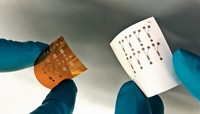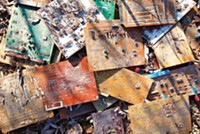Advertisement
Grab your lab coat. Let's get started
Welcome!
Welcome!
Create an account below to get 6 C&EN articles per month, receive newsletters and more - all free.
It seems this is your first time logging in online. Please enter the following information to continue.
As an ACS member you automatically get access to this site. All we need is few more details to create your reading experience.
Not you? Sign in with a different account.
Not you? Sign in with a different account.
ERROR 1
ERROR 1
ERROR 2
ERROR 2
ERROR 2
ERROR 2
ERROR 2
Password and Confirm password must match.
If you have an ACS member number, please enter it here so we can link this account to your membership. (optional)
ERROR 2
ACS values your privacy. By submitting your information, you are gaining access to C&EN and subscribing to our weekly newsletter. We use the information you provide to make your reading experience better, and we will never sell your data to third party members.
Materials
Green Circuit Boards That Biodegrade
By using materials that can dissolve in water in a matter of minutes, scientists offer a way to make greener electronics
by Bethany Halford
October 6, 2014
| A version of this story appeared in
Volume 92, Issue 40
With every new smartphone, tablet, or laptop consumers rush out to buy, there’s usually an older model that’s going to be thrown away. By some estimates as much as 25 million tons of electronic waste is produced globally each year. And roughly 82% of that waste winds up in landfills. Researchers led by John A. Rogers of the University of Illinois, Urbana-Champaign, report a way to make greener printed circuit boards—key components found in all but the simplest electronic devices—that could reduce e-waste. Printed circuit boards are usually made with metals such as gold, silver, palladium, tin, and copper configured with fiberglass or polyimide substrates. Rogers’s team has shown that these slow-to-degrade materials can be replaced by so-called transient metals such as magnesium, tungsten, and zinc formulated as micro- or nanoparticle paste and printed on biodegradable substrates such as sodium carboxymethylcellulose (Adv. Mater. 2014, DOI: 10.1002/adma.201403164). The researchers report that the biodegradable printed circuit boards disintegrate when immersed in water for about 10 minutes, leaving behind only the transient metals, which over the course of hours to days form soluble hydroxides.





Join the conversation
Contact the reporter
Submit a Letter to the Editor for publication
Engage with us on Twitter